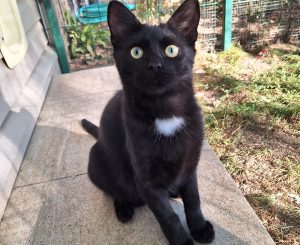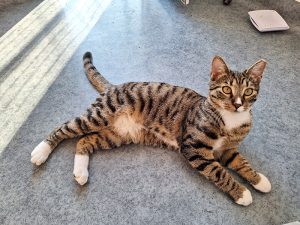Cat motivation
What motivates a cat? Is your cat happy? Learn more on his motivation in this article.
Duke, one of our cats waiting for adoption
There is a common misconception in existence, which suggests that all our feline friends require is a home and delicious food. In reality, when we refer to these two elements, we are referring to a cat’s physical comfort — its ability to live in a cozy, sheltered, and secure environment with plentiful food available. However, in doing so, we are neglecting a fundamental aspect: the emotional well-being of a cat.
Cats also needs to express their interests if they are to lead a fulfilling life
Imagine living in a beautiful house, but never going outside. The same things are available to you the whole time, and someone feeds you every day and brings you medicine if you get sick. It’s a pretty comfortable life, and you want for nothing. You are not exposed to the cold or rain, you can take care of yourself, and you only have to open the refrigerator to lift out your favorite food. But are you sure that you wouldn’t feel something was missing? Might you not have the desire to do other things that interest you? After a while, wouldn’t you start to feel bored or depressed?
Just like us humans, who seek satisfaction in our passions and curiosities, a cat also needs to express its inclinations and interests in order to lead a full and satisfying life. Cats are extremely intelligent, and require stimulation and gratification to avoid falling into a state of apathy.
Deciphering our cats’ motivations can be challenging, and we frequently confine them, inadvertently, to a monotonous lifestyle. In rural settings, cats discover greater satisfaction, as it is easier for them to indulge their natural inclinations. Recognizing the fact that cats are driven by internal factors is paramount, as their motivations are rooted in mental predispositions.

Pompelmo, one of our cats waiting to be adopted
Every cat chooses to express its motivations and interests in a different way
The motivations of a cat are always present. What changes is the manner and intensity with which each cat chooses to express them, based on its own disposition, preferences and abilities. That is why some cats mostly love to play, while others prefer to observe and explore, and yet others are distinctly territorial. Even within the same activity, there can be differences: for example, some cats prefer to play only a couple of times a day, while others would simply never stop.
Cats often sleep all day, not because they exclusively like to sleep or because they are lazy, but because there is nothing else to do in their living environment. Often, in such cases, they do not have the opportunity to satisfy their motivations, not because those motivations are absent, but because the environment in which they live does not enable them to express themselves.

Dilly, uno dei nostri gatti in cerca di una famiglia
What motivates a cat?
A question needs to be posed at this point: what exactly are the motivations of our little feline friends? Here are the main (but not exclusive) factors that need to be taken into consideration:
- Predatory, attracted by the motion and sparkle of a moving object in front of the cat;
- Exploratory, drawn by novelties and and nooks and crannies;
- Athletic, i.e., the pleasure of jumping around and moving in three dimensions;
- Problem-solving, interest in solving problems;
- Et-epimeletic tendency, the pleasure of being looked after, petted, or cared for by their human companions.
Let’s explore why, despite our genuine affection, we have such a hard time gratifying our cats at home.
How to satisfy our cat’s motivation
Regarding predatory motivation, unlike life in the countryside, which is filled with insects and lizards to chase, everyday life in an apartment is a real dead end. Therefore, if we want to entertain our kitty, it is useful to enrich the environment with dangling objects that move and sparkle, as well as rolling objects such as spools and balls, and that we learn to engage them in the right kind of play.

Sakura, ou of our cats waiting for a family
Exploratory tendencies are greatly limited by indoor living, and it is almost impossible to reproduce the complexity of everything a cat may encounter in the external world. However, you can create small nooks and crannies at home, for example, using cardboard boxes with openings, to awaken your cat’s explorer instincts. Alternatively, bring in new items from the outside, such as twigs, leaves, and pebbles. Remember that, for a cat, exploring also means using its sense of smell; it signifies having the opportunity to discover new things and objects. Curiosity is the foundation of exploration.
Cats are real tightrope walkers! We often see them performing the most improbable acrobatic choreographies and are surprised at how skilled they are at judging measurements, even in situations that often seem incredible to us. Therefore, when we take his athletic inclination into consideration, there is no doubt that our apartments greatly limit the cat’s aerobatic desires. This natural inclination finds complete fulfillment outdoors amidst trees. Cats love to climb and leap from one shelf to another, so why not equip your homes with wall supports, create elevated connecting paths, and provide tall and sturdy scratching posts. Making the home three-dimensional signifies creating a space that is more consistent with cats’ natural inclinations.
When we notice our cat engaged in extracting a toy from an enclosed space, employing a form of reasoning, it is its problem-solving motivation that is driving it. Cats are adept at finding strategies to solve small puzzles. In the home, hide treats and toys in boxes, under carpets, or inside snack balls, so that the cat has to work at procuring the food and can engage in a fun and rewarding activity.
Cats also have a strong need for security, which they sometimes express through a behavior called “regression”. This occurs when they curl up on our laps or on a blanket, kneading and purring. In ethology, this is called et-epimeletic behavior, and it requires a careful and confident response from the owner. It’s all too easy to misunderstand this behavior. People often tend to disrupt the cat, showering it with too many caresses, believing it’s seeking cuddles. Alternatively, they may not grasp the cat’s need for security and play small tricks that make the cat uneasy. During these moments, simply indulging our cat and being quietly present is often sufficient.
Every cat is different, and it is up to us to try to learn to understand our feline friends and understand their preferences, because it is only by allowing them to express themselves that we can make our cats truly happy creatures.
